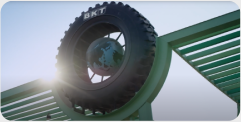Only in the European Union, worn and “tossed away” tires exceed three million tons. in this article we will find out where these tires end up.
Only in the European Union, worn and “tossed away” tires exceed three million tons. Recently, we have already spoken about how to dispose of your tires. We have seen how complex it can be to manage the storage and disposal processes of these products which unfortunately quite often end up in illegal landfills.
Off-Highway tires are even more difficult to dispose of than car tires. They are extremely cumbersome, difficult to move and, obviously, specialized centers for giant tire disposal cannot be found at every corner.

Where do these three million of worn tires end up? Here are a few figures you might find interesting:
- 11% is “dismantled” to be used in production processes for other tires
- 32% is recycled for raw materials to be used in the construction industry
- 34% is used as fuel for generating energy
- 23% unfortunately is still disposed of illegally
How does disposal work?
So, what exactly happens once our tire reaches a regular disposal center? You’ll see:
- Tires are cut for safety reasons
- Components are separated (tube, belts, fibers, rim)
- Rubber parts are crushed into granular form
- Belts are used for producing so called Tire Derived Fuel TDF
- Steel is separated from the crushed rubber by means of magnets
- Steel and granular rubber are resold as recycled material
How can tires be reused?
Once the tire components are separated, how can they be reused? There are two main applications: material for the construction industry and fuel for generating energy.
The recovered materials are excellent components for the production of:
- acoustic and thermal insulation material
- asphalt for road surfaces, speed bumps, traffic limitation and curbs
- rubber protection barriers for train and tram railways
- PVC surfaces, such as bituminous surfaces and membranes
- construction materials used in civil engineering and general public works
From an energy point of view, tire scraps are used to replace traditional fuels especially in the cement production industry. Did you know that burning granular rubber generates the same thermal power than the best coal? What is more, the combustion of such material does not generate CO2 or heavy metal emission into the atmosphere as it is the case of fossil fuels.
Well, it seems that worn tires actually are an important resource for both the environment and the economy: just imagine that only in Europe the tire recycling and disposal industry employs about 10,000 people.
Now, that you know what is going to happen to your tires, remember to go for legal disposal – for both the common good and the environment.





